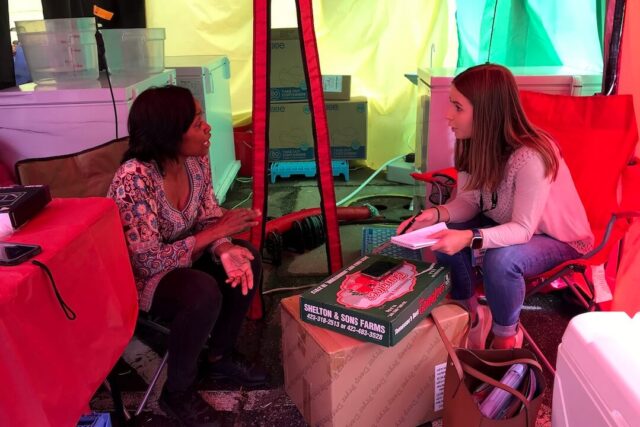Report for America has been in the news this week after I shared during a journalism roundtable that we’re phasing out our support of hedge fund and private equity-owned newsrooms.
The response I’ve seen has been mostly, “About time!” though we’re sympathetic to comments and questions about this decision’s impact on communities and hardworking newsrooms that have no control over their owners’ actions. “Terrible idea,” tweeted Wisconsin Public Radio reporter Corri Hess. “This hurts readers and journalism. Not Gannett, Alden, etc.”
And so I want to explain a bit more about our thinking, which stems from the lessons we’ve learned after fielding more than 600 journalists (we call them corps members) in some 340 local newsrooms throughout the country since 2017, and where we can help local news the most today.
Our program has three constituencies: early career journalists, newsrooms and the communities we hope our newsrooms and corps members will serve well. In our early days, we justified working with chain newsrooms because they were often the only news source serving myriad communities (and still are). Corps members got a decent education in what it means to do community journalism. And we believed improving coverage in those communities was worth the tradeoffs of nonlocal ownership. Cumulatively, only 14% of our portfolio newsrooms have been owned by the largest chains.
Our corps members in hedge fund-owned newsrooms have done terrific work, such as the Green Bay Press-Gazette’s statewide coverage of Wisconsin’s Indigenous community by then-corps member Frank Vaisvilas, a beat he now continues at the Press-Gazette’s sister paper, the Milwaukee Journal Sentinel.
But we’ve also found that the pursuit of profit at others has produced difficult working conditions for our journalists whose careers we’re helping to launch, and are not great fits for the business sustainability tools we have been so successful in helping communities build.
Report for America has proudly partnered with a variety of for-profit (and nondigital) news organizations and will continue to do so, which is also somewhat unique; others are investing exclusively in a nonprofit and digital future. (Our mix this year is 62% nonprofit and 38% for-profit newsrooms.) Our approach in this case is less philosophical and more an evolving understanding of where our model has the most impact. With our scarce resources, we must prioritize partners that will be springboards for the next generation of journalists and will make use of our revenue-generation tools and peer network.
We’ve worked with many such partners. We helped the nonprofit Maine Monitor bring on a series of reporters who produced award-winning journalism no one else was doing. Web traffic and donations skyrocketed, staffing grew — and a former corps member, Kate Cough, was promoted to editor-in-chief. The for-profit Times-Picayune and The Advocate in Louisiana raised enough money from a variety of funders to fully pay for their share of their corps member’s salary, among other programs. And nonprofit El Centro de Periodísmo Investigativo in Puerto Rico, one of 16 Black- and Latino-owned newsrooms we support, has been able to hire multiple corps members after they’ve graduated from our program through strong fundraising and community support.
In these first seven years, here’s more of our track record: Corps members have produced more than 60,000 stories about undercovered topics and communities that wouldn’t have otherwise been reported. We’ve helped our newsrooms raise nearly $30 million in donations, and we’ve provided roughly $20 million in direct salary support. Nearly half of our corps are journalists of color, helping to diversify America’s newsrooms. Eighty-two percent of our alumni are still in journalism.
As we continue to understand where we can be most effective, here’s what we’ve learned and what we need to pursue:
- It’s going to take a variety of business models to address the local news crisis. Nonprofit startups work in some environments, but not in others. For-profit newsrooms that are independent and engaged with their communities have been successful in our program, too. While we are moving away from a small subset of our total newsrooms, we are committed to working with diverse newsroom models to continue to find and support those that will help drive the future of sustainable local news.
- We have to make choices. There is so much need in the local journalism landscape, but when we have limited resources we must refine our model and aim it where it can do the most good. You might think we should focus on the most desperate newsrooms — those about to go under. But newsrooms that don’t offer a living wage, or have an editing team too thin to support an early career reporter, won’t keep a corps member in their community for several months let alone several years (our goal). Conversely, some newsrooms that apply to work with us aren’t especially needy. Again, our target is newsrooms that, with some help, create strategies and practices that might help unlock part of the future for local newsrooms.
- Our partner newsrooms need more and varied support. Recruiting, subsidizing and training journalists for local newsrooms has been a terrific response to the local news crisis: Got a coverage gap? Here’s a talented reporter producing important work, around which newsrooms have built community and we’ve helped them raise money. But our newsrooms have told us they need more from us. That’s why, for example, we’ve been working with community foundations nationwide to establish Community News Funds to support local journalism. It’s why this spring we’ll be offering our newsrooms hands-on support with artificial intelligence tools aimed at improving efficiency. It’s why we partner with other like-minded organizations to be able to offer whatever help is needed for our newsrooms to become more sustainable.
Report for America is actively decoding the evolving needs of newsrooms, journalists, and communities and we welcome your continued feedback. What’s working, and how can we enhance our impact? We need you to join us in the conversation.




